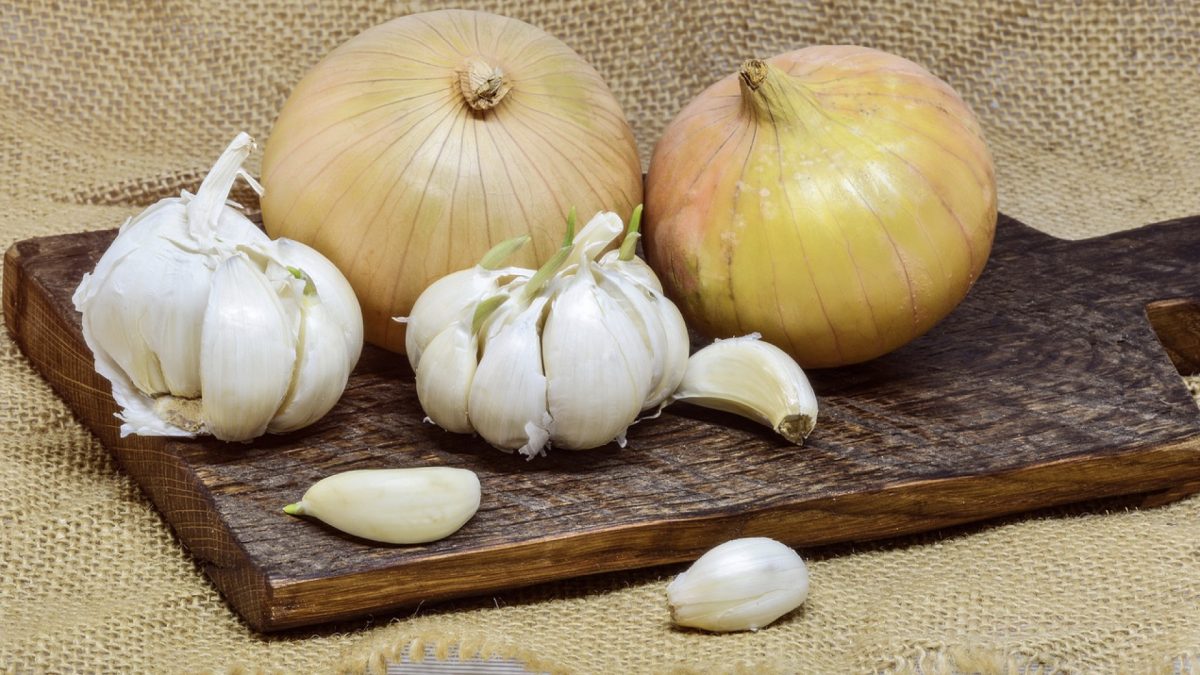As we age, our arteries stiffen. In my video Inhibiting Platelet Activation with Garlic and Onions, you can see charts showing measurements of the stiffness of our aorta, the main artery coming off the heart, as we get older and older. “As the aorta stiffens it leads to a range of linked pathphysiological changes,” such as exposing our brain and kidneys to greater pressure fluctuations, which may increase the risk of stroke and impairment of kidney function.
However, those who consume garlic—less than a quarter teaspoon of garlic powder a day—appear to have less stiffness in their aortas. We think this is because garlic seems to improve the function of the inner lining of our arteries, which helps our arteries relax. But the protective mechanisms of garlic against cardiovascular diseases are multiple, and include a combination of anti-clotting, clot-busting, antioxidant, and blood pressure- and cholesterol-lowering effects. The latest review suggests that long-term garlic intake may drop bad cholesterol levels about 10 percent, and the blood-thinning effects are such that the American Society of Anesthesiology recommends garlic intake be stopped a week before elective surgery.
Or, presumably, you could just cook it to death. Unlike the anticlotting components concentrated in the yellow fluid around tomato seeds, which are heat stable, the antiplatelet activity in garlic and onions is lost with cooking. When comparing platelet inhibition, garlic appears about 13 times more potent than onion, and eating garlic raw appears to be better than cooked. This suggests that “garlic and onion could be more potent inhibitors of blood [clotting] if consumed in raw than in cooked or boiled form.” So, it might be good to cook garlic right before surgery, but what about the rest of the time when we’re trying to suppress platelet over-activity to decrease the risk of heart attacks and stroke? “As garlic and onion are normally consumed in cooked food, their efficacy as preventive herbs in cardiovascular disease may be doubtful.” But, we can put some raw onion on salads and raw garlic in salsa, dressings, dips, or pesto, right?
Or, we can crush or chop it, wait ten minutes, and then cook it. Researchers demonstrated the platelet-inhibiting power of raw garlic. If you cook it for just a few minutes, it does fine; but after cooking for about five minutes, the benefit is abolished. If, however, you pre-crush the garlic and wait, some of the antiplatelet activity is retained a bit longer. That’s because the enzyme that makes the antiplatelet compounds is activated by crushing but destroyed by heat faster than it creates the compounds. So, by crushing first and letting the enzyme work its magic before cooking, one can delay the loss of function.
Even better, though, is that, (as I discussed in my video Second Strategy to Cooking Broccoli with mustard powder), the addition of a little raw garlic juice to cooked garlic can restore the “full complement of antiplatelet activity that was completely lost without the [raw] garlic addition.”
When onions are cooked, the antiplatelet activity is similarly abolished within ten minutes, but then something strange happens. After 20 or 30 minutes of cooking, the effect on platelets is reversed and appears to make matters worse. Significant pro-platelet activation effects are seen, “suggesting that extensively cooked onions may stimulate rather than inhibit” platelets. That was in a test tube, though. Thankfully, when tested in people, even when onions are dropped in boiling water, fried for 10 minutes, and then left to simmer for 30 minutes, platelet activation drops within one to three hours after eating onion soup.
For background on what platelets are, what they do, and why we should care, see Inhibiting Platelet Aggregation with Berries and Inhibiting Platelet Activation with Tomato Seeds.
What else can garlic do? Check out:
- Cancer, Interrupted: Garlic and Flavonoids
- Garlic and Raisins to Prevent Premature Birth
- Food Synergy
What was that about mustard powder boosting the benefits of broccoli? See my Second Strategy to Cooking Broccoli video. Broccoli is also a potent activator of our liver’s detoxifying enzymes. Learn more in my Best Food to Counter the Effects of Air Pollution video.
Wondering whether it’s better to cook vegetables or eat them raw? See Best Cooking Method and for a surprise update, The Best Way to Cook Sweet Potatoes.
In health,
Michael Greger, M.D.
PS: If you haven’t yet, you can subscribe to my free videos here and watch my live, year-in-review presentations:
- 2012: Uprooting the Leading Causes of Death
- 2013: More Than an Apple a Day
- 2014: From Table to Able: Combating Disabling Diseases with Food
- 2015: Food as Medicine: Preventing and Treating the Most Dreaded Diseases with Diet
- 2016: How Not To Die: The Role of Diet in Preventing, Arresting, and Reversing Our Top 15 Killers
